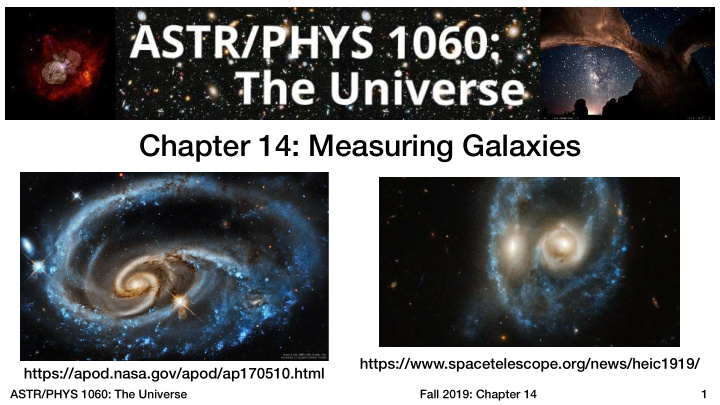



Chapter 14: Measuring Galaxies https://www.spacetelescope.org/news/heic1919/ https://apod.nasa.gov/apod/ap170510.html ASTR/PHYS 1060: The Universe Fall 2019: Chapter 14 � 1
Now on to Galaxies! ASTR/PHYS 1060: The Universe Fall 2019: Chapter 14 � 2
Classifying Galaxies • Groups of 2-4, one sheet per group • One person from each group raise your hand (so TAs can efficiently pass out dead tree shavings) • First step: Once I display the 8 galaxies onscreen, begin! What is the overall shape of the galaxy? Is it smooth or mottled? What else do you find notable about it? • When finished with Questions 1-4, display your ABCD card so I know when you’re done. ASTR/PHYS 1060: The Universe Fall 2019: Chapter 14 � 3
M87 M110 NGC 1300 M81 ASTR/PHYS 1060: The Universe Fall 2019: Chapter 14 � 4
NGC 3628 NGC 4449 NGC 1232 Sombrero ASTR/PHYS 1060: The Universe Fall 2019: Chapter 14 � 5
How did you classify the galaxies? M110 NGC 3628 NGC 1300 NGC 4449 NGC 1232 M81 M87 Sombrero ASTR/PHYS 1060: The Universe Fall 2019: Chapter 14 � 6
NGC 4731 Question 5 : Try to incorporate these into your classification. Where would they go? Cen A ASTR/PHYS 1060: The Universe Fall 2019: Chapter 14 � 7
How did you classify the galaxies? M110 NGC 3628 NGC 1300 NGC 4449 NGC 1232 M81 M87 Sombrero ASTR/PHYS 1060: The Universe Fall 2019: Chapter 14 � 8
Hubble’s Classification Scheme: Tuning Fork Diagram ASTR/PHYS 1060: The Universe Fall 2019: Chapter 14 � 9
ASTR/PHYS 1060: The Universe Fall 2019: Chapter 14 � 10
ASTR/PHYS 1060: The Universe Fall 2019: Chapter 14 � 11
Appearance depends on orientation… ASTR/PHYS 1060: The Universe Fall 2019: Chapter 14 � 12
…and the motions of stars Bulges and Ellipticals ASTR/PHYS 1060: The Universe Fall 2019: Chapter 14 � 13
Disk and Spiral Galaxies Which type of galaxy (Disk or Elliptical) is our galaxy, the Milky Way? Why do you think so? ASTR/PHYS 1060: The Universe Fall 2019: Chapter 14 � 14
Color vs stellar age A) Older stars have bluer colors B) Older stars have redder colors C) Stellar colors do not depend on age ASTR/PHYS 1060: The Universe Fall 2019: Chapter 14 � 15
A Which galaxy is oldest? Which galaxy is prettiest? C B ASTR/PHYS 1060: The Universe Fall 2019: Chapter 14 � 16
Why is there a connection between shape & stellar age? Hint: it’s analogous to planets in star systems Stars form from gas — gas settles into a disk due to angular momentum conservation! ASTR/PHYS 1060: The Universe Fall 2019: Chapter 14 � 17
Spiral arms are density waves (like sound waves) ASTR/PHYS 1060: The Universe Fall 2019: Chapter 14 � 18
Galaxies are not isolated ASTR/PHYS 1060: The Universe Fall 2019: Chapter 14 � 19
ASTR/PHYS 1060: The Universe Fall 2019: Chapter 14 � 20
https://www.youtube.com/watch?v=52k-VryS1hs ASTR/PHYS 1060: The Universe Fall 2019: Chapter 14 � 21
Active Galactic Nuclei (AGN) <—> Supermassive Black Holes (SMBHs) more or less all galaxies have an SMBH, and its mass is proportional to the mass of its bulge Cygnus A Galaxy (optical) Jets from its AGN (radio) M87 Centaurus A ASTR/PHYS 1060: The Universe Fall 2019: Chapter 14 � 22
But how are galaxies moving? ASTR/PHYS 1060: The Universe Fall 2018: Chapter 5 � 23
Doppler Shift of Light A λ observed − λ emitted = ∨ c λ emitted B Which spectrum is moving away C from us the fastest? D ASTR/PHYS 1060: The Universe Fall 2018: Chapter 5 � 24
λ observed − λ emitted = ∨ Almost all galaxies are moving away from us. c λ emitted ASTR/PHYS 1060: The Universe Fall 2018: Chapter 5 � 25
We live in an expanding “balloon universe” ASTR/PHYS 1060: The Universe Fall 2019: Chapter 14 � 26
What are the spiral nebulae? The great debate of 1920 Harlow Shapley Herber Curtis MW is whole Universe MW is one of many galaxies • Sun is in outer part of the MW • Sun is at the center of MW • M31 would have to be at an insane • M31 has too many novae to be just distance to be similar a galactic nebula • we can see rotation in the Pinwheel • we see dust lanes in other nebulae, • this one nova in M31 would have like the MW’s been impossibly bright ASTR/PHYS 1060: The Universe Fall 2019: Chapter 14 � 27
Edwin Hubble settles the debate M31: Andromeda Galaxy ASTR/PHYS 1060: The Universe Fall 2019: Chapter 14 � 28
Hubble’s Law ASTR/PHYS 1060: The Universe Fall 2019: Chapter 14 � 29
Distance Ladder ASTR/PHYS 1060: The Universe Fall 2019: Chapter 14 � 30
Parallax Spectroscopic Parallax Type Ia SNe Cepheid Variables ASTR/PHYS 1060: The Universe Fall 2019: Chapter 14 � 31
What is the dominant factor that determines a galaxies appearance? A) Total Mass B) Age of stars C) Environment D) All of the above ASTR/PHYS 1060: The Universe Fall 2019: Chapter 14 � 32
What are galaxies mostly made of? A) Stars B) Stellar Remnants C) Gas D) Who knows? ASTR/PHYS 1060: The Universe Fall 2019: Chapter 14 � 33
What are galaxies mostly made of? ASTR/PHYS 1060: The Universe Fall 2019: Chapter 14 � 34
Can estimate the mass of elliptical galaxies from its hot, X-ray emitting gas ASTR/PHYS 1060: The Universe Fall 2019: Chapter 14 � 35
What is dark matter? • Most likely a new kind of matter (but possibly a modification to general relativity) • Does not absorb or emit light • Interacts very weakly, except through its gravity • WIMP or MACHO? Axion or sterile neutrino? ASTR/PHYS 1060: The Universe Fall 2019: Chapter 14 � 36
Recommend
More recommend